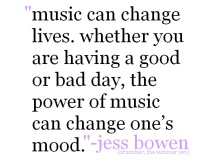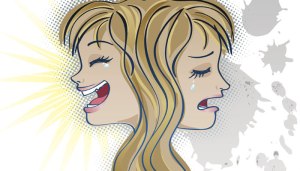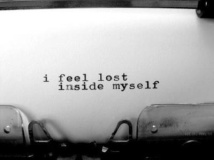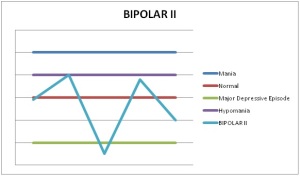Music has the power to evoke emotions and feelings, transport you to a moment in time, soothe, express and can fleetingly remind you of various people for various reasons. Music for me well it can do a multitude of things…it can encourage me to write both academically or for pleasure; whilst at university I often listened to music to get me through deadlines and even know I tend to listen to Spotify whilst writing this blog. It can have the power to impede my mood and emotions both positively and negatively.
or for pleasure; whilst at university I often listened to music to get me through deadlines and even know I tend to listen to Spotify whilst writing this blog. It can have the power to impede my mood and emotions both positively and negatively.
Whilst on the bus home from shopping a few days ago I put my headphones in; a reaction which comes natural to me nowadays. I tend to listen to my music on shuffle…every song with the ability to invoke emotions, transport me to a particular time or place in my life or remind me of certain people. Now there were songs which I was quick to skip over those which could negatively affect my mood but others I ruminated on…songs which reminded me of Summer, nights out and memories with friends both those which made me smile to recall and those which made me smile to remember those whom were a big part of my life whom sadly are no longer. This got to me thinking why is Music so influential in a person’s mood, behaviour and emotions…it seems relatively obvious to most people and I am sure that I am not the only person to ponder on this notion.
 Whilst reading a book recently music was brought to the forefront of my mind; the book is an autobiographical account of a daughter whom is learning to cope and understand dementia and it’s affects on her mother. She noted that when her mother was feeling uneasy and anxious she could quite quickly change her mood by singing a song which her mother used to sing her when she was a young child. Then when the progression of dementia took over her loving mother, the life and soul of the party where seemingly she had lost her sense of self music had the power to not only bring her back but was found to be a great therapeutic technique for many degenerative diseases such as Dementia. The book didn’t really look into scientific studies but the basic premise was that due to the different areas of the brain which music can affect it would be more likely to cause a reaction and spark the memory which otherwise was compromised. I’ve since lent the book to another person so can’t directly quote what was said but the daughter spoke to a specialist whom stated that due to the differing areas which music can affect; tone, beat, rhythm, lyrics and the memories associated are most likely to affect some area of the brain and can be compelling in seeing a spark of a person pre-symptoms of diseases.
Whilst reading a book recently music was brought to the forefront of my mind; the book is an autobiographical account of a daughter whom is learning to cope and understand dementia and it’s affects on her mother. She noted that when her mother was feeling uneasy and anxious she could quite quickly change her mood by singing a song which her mother used to sing her when she was a young child. Then when the progression of dementia took over her loving mother, the life and soul of the party where seemingly she had lost her sense of self music had the power to not only bring her back but was found to be a great therapeutic technique for many degenerative diseases such as Dementia. The book didn’t really look into scientific studies but the basic premise was that due to the different areas of the brain which music can affect it would be more likely to cause a reaction and spark the memory which otherwise was compromised. I’ve since lent the book to another person so can’t directly quote what was said but the daughter spoke to a specialist whom stated that due to the differing areas which music can affect; tone, beat, rhythm, lyrics and the memories associated are most likely to affect some area of the brain and can be compelling in seeing a spark of a person pre-symptoms of diseases.
Despite the focus of Dementia surely as I know myself this happens to all of us. I know that; ‘I’ve had the time of my life’ from Dirty Dancing can take me back to my college prom as it was the last song, similarly ‘Sing’ by Gary Barlow and The Military Wives can take me back to my last few days at college- our form tutor played it us on our last day, ‘Come on Eileen‘ invokes memories of irritating my Mum- it’s not her favourite song in the world, ‘Bohemian Rhapsody‘ reminds me of English Literature classes at college- we were studying Paradise Lost by John Milton refers to Beelzebub similarly as Queen does it was sang frequently during our studies of Paradise Lost likewise Colplay’s ‘Paradise‘ in the same vain, any song by Westlife reminds me of my Grandma and conjures memories of her, The Housemartins ‘Caravan of Love‘ takes me back to year 7 we all had to sing a song when we first started at secondary school-that was ours, Queen ‘Crazy Little Thing Called Love‘ and ‘Brown Eyed Girl’ by Van Morrison reminds me of my Aunt and Uncle, ‘Rotterdam‘ by The Beautiful South reminds me of being in Amsterdam with my best-friend, Alicia Keys ‘Empire State of Mind‘ takes me back to Year 9 when we went on a school trip to New York, ‘Build me up Buttercup‘ by The Foundations reminds me of my friends from university, again songs with names in also evoke memories of people which I shall not name as it would be obvious whom they are related to, any Eminem or 50 Cent Song can take me back to going camping with my brother and my Dad, ‘Peanut Butter Jelly‘ by Galantis and David Zowie’s ‘House Every Weekend‘ takes me to my 21st birthday in a sunny field with my two best-friends at Creamfields, ‘Nessun Dorma‘ by Pavorotti, ‘Fast Car‘ by Tracey Chapman and ‘I love it‘ by Icona Pop also conjures images of my best-friend driving when he first got his car, ‘Poker Face‘ by Lady Gaga and ‘My Girl‘ by the Temptations remind me of my Dad and memories associated with him and those songs, ‘Bangerang‘ by Skrillex, ‘Ni**as in Paris‘ by JayZ and Kanye West and ‘212‘ by Azelia Banks takes me to my first year at university, similarly individual songs I have unconsciously paired with people in my life and when those come on they are the person which first comes into my mind for example, a very old song called ‘Waiting at the Church‘ makes me think of my Gran as she has sung it to me numerous times, ‘Let it Go‘ by James Bay and any song my Catfish and the Bottlemen reminds me of someone who also liked those artists and songs and finally, ‘Valerie‘ by Amy Winehouse reminds me of my best-friend’s Grandma who meant a lot to me.
Music has the power to improve, challenge and affect a person’s mood I know one song which I can no longer listen to due to me listening to it when I wasn’t too well- I imagine that it would be difficult to listen to due to the memories and emotions associated with it.I know for me personal upbeat music can empower and energise me to get things done, soothing and calming music does just that, music can also get me in the mood to go on a night out and finally music can also shut you out from the world and forget what’s on the other side of your headphones.
Music and lyrics especially has the power in conveniently puts into words what you cannot express and sometimes seems to explain your life or a part of your life more than you can say. I by no means am a musical person I can at best press the ‘DJ’ button on a keyboard- a staple of growing up in the UK when having loosely referred to music lessons. I at a time also had singing lessons again ‘Downtown‘ by Petula Clark takes me back to that time in my life. As you have already figured out I am by no means a singer other than in the shower and when no one is around but music itself if you can play, write or sing (well or otherwise) has the ability to express and free yourself from societal ties which we are all affected by nowadays. Even throughout writing this blog I have lent towards lyrical quotes from songs to explain or portray what I am trying to express.
Now for Music and Mental Health, Mind released information that when listening to music the neurotransmitter Dopamine (the feel-good hormone) is released and volunteers whom listened to music they liked their Dopamine levels were 9% higher in those individuals. Therefore Mind and the researchers carrying out that study are linking music and mental well-being. So music has the power to affect our mood, emotions and behaviours and seemingly is being introduced in the treatment of mental health and has been used in degenerative disease therapies for a while now. So bare in mind that the song your listening to at the moment in 10 years to come you may hear it and it will take you back to this time in your life, a song you sing as a joke like me with ‘Candy Shop‘ by 50 Cent (in a posh voice may I add) or ‘Three Little Birds‘ by Bob Marley will remind others of you and songs you specifically listen to when your down may always have that negative affect on your life so bare it in mind when your next listening to music.
To put it bluntly music has the power to; empathise, express, energise, motivate, soothe, calm, uplift, capture moments and feelings, take you back to a particular time in your life, affect your mood both positively and negatively, and lets face it it makes the world a little more bearable…I do wonder how we would all cope without music…it does really affect a person’s soul doesn’t it? If you really think about it. Now put on a song which makes you think of me – if you need to and know I am with you wherever you are perhaps not in body but in spirit and through the lovely voices of those singing- hopefully you’ve not put some god awful scream music on right now! Let me know what it is! Or just put on Louis Armstrong ‘What a wonderful World’ or Bill Withers ‘Lean on Me‘ I find they are quite uplifting songs- listen to the lyrics.
Good bye for now!
*Note; I have a very eclectic mix of music tastes and this is just a snapshot of songs which immediately make me think of of time, place or people in my life. Like a walk back through memories getting all the links for the songs.
Further Information;
Mind; http://www.mind.org.uk/information-support/your-stories/why-music-is-great-for-your-mental-health/
News Article; http://www.bbc.co.uk/news/health-12135590













 Lithium is probably one of the most well-known treatments for people with Bipolar disorder. This form of medication can be very effective treatment for mania, but is less effective in treating symptoms of Depression (Smith,2012). It helps to reduce the severity and frequency of mania, and is often the long-term method of treating Bipolar disorder (Geddes et al., 2004).Evidence suggests that Lithium is most effective for;
Lithium is probably one of the most well-known treatments for people with Bipolar disorder. This form of medication can be very effective treatment for mania, but is less effective in treating symptoms of Depression (Smith,2012). It helps to reduce the severity and frequency of mania, and is often the long-term method of treating Bipolar disorder (Geddes et al., 2004).Evidence suggests that Lithium is most effective for;
 Some people suffering from Bipolar disorder may be prescribed anti-depressants. A commonly prescribed anti-depressant is SSRI’s (selective serotonin re-uptake inhibitors- see ‘The strive for the right medication’ for an explanation of SSRI’s).
Some people suffering from Bipolar disorder may be prescribed anti-depressants. A commonly prescribed anti-depressant is SSRI’s (selective serotonin re-uptake inhibitors- see ‘The strive for the right medication’ for an explanation of SSRI’s). 







